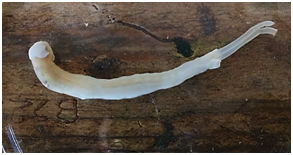
In 1892, based on a popular saying, Henri de Lacaze-Duthiers (1821-1901), founder of the Laboratoire Arago de Banyuls, wondered whether the "music" of the shipworm could be audible to the human ear. In a short account that he was unable to verify the adage:

“This wood comes from a holding tank [at the laboratory] in Banyuls, where it stayed submerged, for less than a year. [...] There is a saying at the coast: "these little animals make their music."
I tried to hear these sounds they make when they attack the wood, but I couldn't manage it.”
One hundred and thirty years later, we can now confirm that the saying is true. We have recorded the sounds produced by the shells of the shipworm scraping at the inside of pine boards immersed in the bay of Banyuls-sur-Mer. These rasping sounds, are faint, but their frequencies are well within the range audible to the human ear. The recordings indicate pauses of several seconds long between short bursts of activity, during which one perceive the sharp sounds of the valves contacting and then pulling across the wood surface.
Click and listen ...
Today, teridinids continue to be a concern for the conservation of marine and underwater archaeological heritage, but they have also become a biological model for testing ecological concepts and understanding the transformation of cellulose into green energy biomass. Modern means of capturing sounds open up the prospect of determining whether their biological activity follows a circadian rhythm, or whether the vibrations produced may constitute a signal of the presence of a another individual? Thus, sound is perhaps, the key to understanding why and how the galleries bored by the shipworm remain separate, and only rarely intersect.
Source: Charles, F., Coston-Guarini, J. 2021. “Hey, do you hear me? ”: The elusive song of the shipworm. The Naval Shipworm Teredo navalis A Global Player and its Entangled Histories M. Vennen, Humboldt University of Berlin (BMBF-research project “Animals as Objects"); R. Schilling, German Maritime Museum/ Leibniz-Institute for Maritime History. Online-Workshop, 21.-22.1.2021.